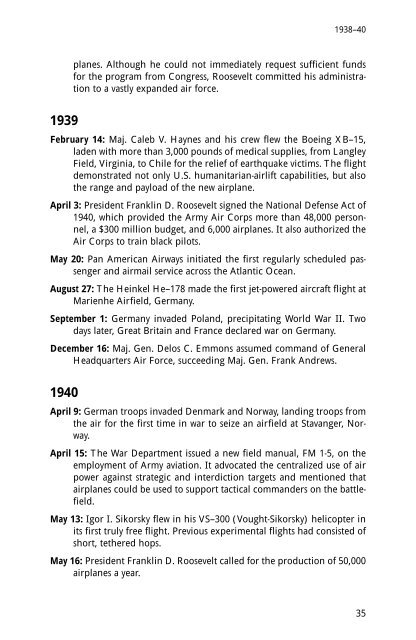One Hundred Years of Flight USAF Chronology ... - The Air University
One Hundred Years of Flight USAF Chronology ... - The Air University
One Hundred Years of Flight USAF Chronology ... - The Air University
Create successful ePaper yourself
Turn your PDF publications into a flip-book with our unique Google optimized e-Paper software.
1939<br />
planes. Although he could not immediately request sufficient funds<br />
for the program from Congress, Roosevelt committed his administration<br />
to a vastly expanded air force.<br />
February 14: Maj. Caleb V. Haynes and his crew flew the Boeing XB–15,<br />
laden with more than 3,000 pounds <strong>of</strong> medical supplies, from Langley<br />
Field, Virginia, to Chile for the relief <strong>of</strong> earthquake victims. <strong>The</strong> flight<br />
demonstrated not only U.S. humanitarian-airlift capabilities, but also<br />
the range and payload <strong>of</strong> the new airplane.<br />
April 3: President Franklin D. Roosevelt signed the National Defense Act <strong>of</strong><br />
1940, which provided the Army <strong>Air</strong> Corps more than 48,000 personnel,<br />
a $300 million budget, and 6,000 airplanes. It also authorized the<br />
<strong>Air</strong> Corps to train black pilots.<br />
May 20: Pan American <strong>Air</strong>ways initiated the first regularly scheduled passenger<br />
and airmail service across the Atlantic Ocean.<br />
August 27: <strong>The</strong> Heinkel He–178 made the first jet-powered aircraft flight at<br />
Marienhe <strong>Air</strong>field, Germany.<br />
September 1: Germany invaded Poland, precipitating World War II. Two<br />
days later, Great Britain and France declared war on Germany.<br />
December 16: Maj. Gen. Delos C. Emmons assumed command <strong>of</strong> General<br />
Headquarters <strong>Air</strong> Force, succeeding Maj. Gen. Frank Andrews.<br />
1940<br />
1938–40<br />
April 9: German troops invaded Denmark and Norway, landing troops from<br />
the air for the first time in war to seize an airfield at Stavanger, Norway.<br />
April 15: <strong>The</strong> War Department issued a new field manual, FM 1-5, on the<br />
employment <strong>of</strong> Army aviation. It advocated the centralized use <strong>of</strong> air<br />
power against strategic and interdiction targets and mentioned that<br />
airplanes could be used to support tactical commanders on the battlefield.<br />
May 13: Igor I. Sikorsky flew in his VS–300 (Vought-Sikorsky) helicopter in<br />
its first truly free flight. Previous experimental flights had consisted <strong>of</strong><br />
short, tethered hops.<br />
May 16: President Franklin D. Roosevelt called for the production <strong>of</strong> 50,000<br />
airplanes a year.<br />
35

















